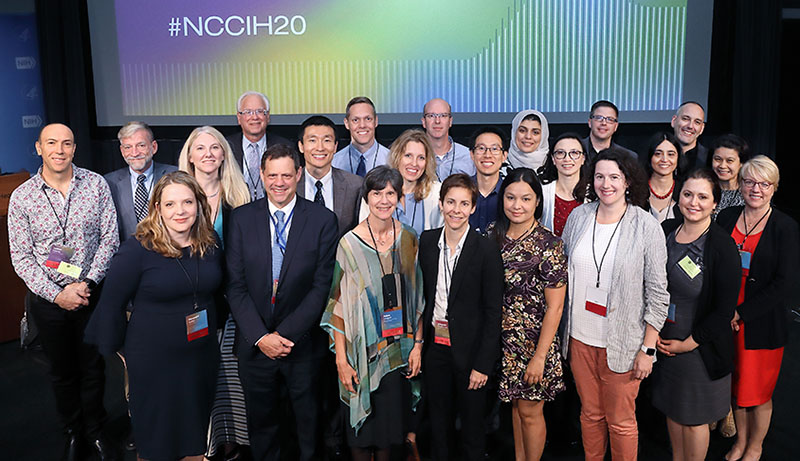NCCIH Researchers Highlighted in Anniversary Symposium
NCCIH at 20: A Catalyst for Integrative Health Research
One of the top research priorities of the National Center for Complementary and Integrative Health (NCCIH) is to support studies that explore the nonpharmacologic management of pain. On September 23, NCCIH celebrated its 20th anniversary with a symposium that featured a keynote talk by Lorimer Moseley (University of South Australia in Adelaide, South Australia) on “Why We Need a Pain Revolution: From Science to Practice,” lightning-round presentations from NCCIH-supported early-stage researchers, and two panel discussions, one on pain research in military and veteran populations and the other on on the future of natural products research.

CREDIT: CHIA-CHI CHARLIE CHANG, OD
All the speakers of “NCCIH at 20: A Catalyst for Integrative Health Research.” Row 1 (left to right): Cassandra Quave, David Shurtleff (Deputy Director, NCCIH), Helene Langevin (Director, NCCIH), Amanda Shallcross, Yarimar Carrasquillo (NCCIH), Lauren Atlas (NCCIH), Maren Nyer, Christine Goertz; Row 2: Lorimer Moseley, Robert Kerns, Wendy Weber (NCCIH), Zirui Song, Nadja Cech, Patrick Shih, Wen Chen (NCCIH), Medha Pathak, Jiang-Ti Kong; Row 3: Martin Blaser, Donald McGeary, Craig Hopp (NCCIH), Omayma Alshaarawy, Brent Leininger, Alex Chesler (NCCIH).
Three NCCIH intramural tenure-track researchers were among 11 early-stage investigators selected from around the nation to present their research at the symposium, held in Lipsett Amphitheater. In a lightning round of five-minute talks, the speakers introduced some of their projects and findings on pain.
NCCIH’s Division of Intramural Research is led by Scientific Director and Senior Investigator Catherine Bushnell, whose main research focus is the mechanisms and underlying neurobiology of pain.
In his lightning-round talk, Alexander Chesler, an Earl Stadtman investigator and chief of NCCIH’s Sensory Cells and Circuits Section, described his work on mechanosensation. He talked about one of the studies that he and Carsten Bönnemann (National Institute of Neurological Disorders and Stroke) are doing with a group of Clinical Center patients who have Piezo-type mechanosensitive ion channel component 2 (PIEZO2) deficiency syndrome. PIEZO2 is an ion channel that is abundantly expressed in sensory neurons. Hallmarks of the syndrome include skeletal abnormalities, major deficits in proprioception (knowing where one’s own body is in space), and selective deficits in touch. Yet these Clinical Center patients can feel temperature and acute-pain sensations, and they have no cognitive deficits.
Understanding how mutations in the PIEZO2 gene are linked to such specific phenotypes has been a major focus of Chesler’s ongoing work. He and his colleagues are studying this topic in vitro by taking cells from patients, using stem-cell technology to program them into human-touch neurons, and applying gene editing to “correct the gene mutations in a dish.” They are also exploring cellular mechanisms in vivo by creating and examining animal models. “We see neurons beautifully responding to touch, and these responses are absent in PIEZO2-deficient mice,” Chesler said.
Lauren Atlas is exploring the mechanisms by which psychological factors influence pain. Atlas, who is the principal investigator and chief of NCCIH’s Section on Affective Neuroscience and Pain, and her team study acute pain in humans to try to understand how different responses to heat ultimately lead to subjective pain. Her talk focused on how learning from experience is altered by verbal instructions and anxiety. Much of the evidence about psychological modulation of pain relies on many decades of work on placebo effects. The two factors traditionally believed to be most influential have been instructions (verbal or written) and the person’s prior experiences in the treatment context (which influence learning and memory). These two factors were thought to be mediated by two different brain systems: 1) the prefrontal cortex (activated by goals and explicit knowledge) and 2) the striatum and amygdala (activated by emotional learning and memory).
Atlas has found, however, that these systems can interact, particularly in anxious individuals. In a paper in press, she reports her findings that instructions, learning, and anxiety can influence the pain experience and the body’s response to pain. Further research on these relationships could eventually inform choices of therapies such as cognitive behavioral therapies versus learning through exposure. “If we leverage these influences” in treating pain and anxiety, she said, “we can maximize patient outcomes.”
The amygdala is the focus of Yarimar Carrasquillo’s research on pain. She is the principal investigator and chief of NCCIH’s Behavioral Neurocircuitry and Cellular Plasticity Section. A major question is “What are the mechanisms that allow pain to modulate upward to and/or downward from the brain?” Since the early 1980s, there have been conflicting views on whether the amygdala is more a promoter or an inhibitor of pain.
The amygdala is part of the limbic system, which controls basic emotions such as fear, pleasure, and anger and drives such as hunger, sex, dominance, and care of offspring. Carrasquillo’s team has found evidence that it is both a promoter and an inhibitor of pain, and she has begun to identify the responsible mechanisms.
To explore a hypothesis that the modulation is cell type– and circuit-specific, her team uses molecular-genetic strategies in two cell populations (protein kinase C delta–expressing and somatostatin-expressing cells) in mice. “We are trying to create a road map of what the circuits and mechanisms are doing in this beautiful modulation [of pain],” she said. “We take an airplane view and then zoom in at different sites to identify the cellular and synaptic mechanisms that are drivers.”
“This exciting work gives insight into the breadth of NCCIH-funded research, said Emmeline Edwards, director of NCCIH’s Division of Extramural Research. “These accomplished young investigators are advancing the field of complementary and integrative health in myriad ways, and we look forward to watching the trajectories of their careers.”
To view the videocast of NCCIH’s 20th anniversary symposium, held on September 23, 2019, go to https://videocast.nih.gov/launch.asp?28743. For more information including the agenda go to https://nccih.nih.gov/news/events/NCCIH-20.
This page was last updated on Wednesday, March 30, 2022
